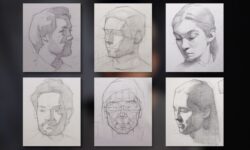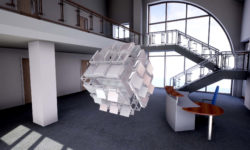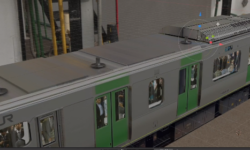Illustrator CC 2018 One-on-One Mastery
Release date:2018, March 23
Duration:18 h 15 m
Author:Deke McClelland
Skill level:Beginner
Language:English
Exercise files:Yes
Design and create amazing works of art using Adobe Illustrator CC 2018, the powerful vector-based drawing program. This comprehensive training is the first in a series of three courses by industry pro Deke McClelland. Learn how to work with artboards; how to draw anything you can imagine with the Pen, Pencil, and Curvature tools; and how to start adding color to your artwork with swatches. Deke also covers drawing shapes, adjusting strokes, formatting text, and painting digitally, with or without a tablet. Each chapter should leave you with a new set of skills—and a sense of accomplishment.
As Creative Cloud evolves, this course gets updated. Check back for new videos, new feature reviews, and new ways to work.
Topics include:
- Opening, creating, saving, and closing documents
- Working with artboards
- Zooming and panning
- Drawing lines, arcs, grids, and spirals
- Drawing shapes
- Creating compound paths
- Working in RGB vs. CMYK color modes
- Creating and applying swatches
- Adjusting the line weight of strokes
- Formatting text
- Building custom paths with the Shape Builder and Join tools
- Freeform drawing with the Pencil
- Painting and erasing artwork
- Drawing with the Curvature tool
- Reshaping rounded paths
- Making screen graphics
Introduction
Welcome to One-on-One 4m 21s
A few important items before we begin 5m 46s
1. Working with Documents
A first look at Illustrator 50s
Opening from the Windows desktop 7m 9s
Opening from the Macintosh Finder 8m 59s
Introducing the Start screen 5m 27s
Creating a new document 6m 16s
The units of design: Points and picas 7m 34c
The advanced document settings 6m 43s
Modifying your new document 7m 57s
Saving your changes 7m 52s
Closing open documents on the PC 4m 36s
Closing open documents on the Mac 6m 6s
2. Working with Artboards
Pages of any size, at any angle 1m 3s
Using the Artboard Tool 10m 51s
Undo, Redo, and Revert 3m 21s
Selecting multiple Artboards 8m 14s
Creating and duplicating Artboards 8m 19s
Five ways to resize Artboards 8m 11s
Introducing the Artboards panel 6m 6s
Navigating between Artboards 5m 43s
Aligning and distributing Artboards 7m 13s
Automatically tidying up your Artboards 7m 29s
3. Getting Around
Navigating your artwork 43s
Zooming in and out 5m 59s
Using the more precise Zoom tool 6m 22s
Zooming on a selection (or not) 2m 12s
Animated zooming and GPU Performance 7m 48s
Scrolling (or panning) a document 4m 6s
Specifying a custom zoom level 4m 18s
Working with multiple open Documents 5m 49s
Customizing your panels (important!) 9m 36s
Saving your custom panels as a workspace 2m 26s
Cycling between screen modes 6m 38s
4. Drawing lines
Now, we draw 44s
Creating center guides 8m 3s
Using the Line Segment Tool 6m 55s
Drawing straight lines 5m 24s
Duplicating and Extending 6m 21s
Using the Move command 5m 19s
Introducing the Scissors tool 4m 20s
Joining your line segments 5m 23s
Using the Arc Tool 6m 45s
Using the Rectangular Grid tool 7m 52s
Using the Polar Grid tool 3m 29s
Using the Spiral tool 7m 31s
Adding a circular end to a spiral 4m 42s
Adjusting the curvature of an Arc 6m 7s
Centering all artwork on an artboard 3m 46s
5. Drawing Shapes
And now, we draw better 43s
Creating a time-saving template 5m 18s
Using the Ellipse tool 7m 45s
Live ellipses and pies 4m 44s
Drawing two perfectly aligned circles 8m 22s
Creating compound paths 7m 1s
Using the Rectangle tool 5m 40s
The dynamic round corner controls 7m 39s
Adding some simple reflections 7m 49s
Rotating your artwork into position 6m 19s
Using the Polygon and Star tools 6m 8s
Working with live polygons 7m 3s
Creating the perfect five-pointed star 6m 10s
Repeating stars in alternating rows 6m 23s
Introducing the Group Isolation mode 7m 12s
Adding a drop shadow to a layer 2m 54s
Using the crazy Flare tool 6m 19s
The top-secret tilde key trick 3m 53s
6. Color and Swatches
How color works 1m 7s
The color modes: RGB vs. CMYK 8m 7s
Hue, saturation, and brightness 4m 56s
Selecting a color from the spectrum ramp 5m
Creating and applying swatches 7m 40s
Working with global swatches 7m 9s
Searching swatches by name 5m 1s
Auto-deleting and adding swatches 4m 43s
Using the Eyedropper tool 5m 8s
Loading swatches from another document 4m 18s
7. Strokes, Dashes, and Arrows
The rich world of strokes 43s
Adjusting the line weight 4m 42s
How strokes align to path outlines 6m 45s
Caps, joins, and miter limit 6m 25s
Making practical use of caps and joins 6m 7s
Dashes and arrowheads 7m 24s
Variable-width strokes 5m 58s
Numerically adjusting Width points 5m 25s
Custom aligning strokes to paths 3m 21s
Creating a custom Width Profile 7m
Creating a classic round-dotted outline 3m 25s
Drawing a quick-and-dirty gear 7m 6s
Combining multiple strokes 4m 18s
Offsetting strokes to simulate depth 6m 8s
8. Creating and Formatting Type
Text at its best 1m 2s
Setting up page margins 7m 54s
Placing and flowing text 6m 43s
Creating multicolumn text frames 5m 41s
The Smart Punctuation command 4m 8s
Working with point type 7m 2s
Formatting display text 8m 39s
Fitting headline and optical kerning 7m 55s
Formatting body copy 8m 14s
Creating a drop cap 3m 39s
Wrapping text around a graphic 7m 37s
Resolving widows and orphans 4m 49s
Working with the Glyphs panel 8m 12s
Hunting down elusive characters 5m 31s
Creating a paragraph style 7m 6s
Redefining a paragraph style 6m 48s
Creating type on a path 7m 47s
9. Building Custom Paths
Join and the Shape Builder 1m 12s
Using the Join command 6m 26s
Using the Join tool 4m 16s
Using the Shape Builder tool 5m 1s
More ways to use the Shape Builder 6m 20s
Creating a real-world project 6m 4s
Creating an inset reflection 6m 32s
Coloring a path with the Shape Builder 5m 31s
Sculpting with variable-width strokes 4m 42s
Converting text to path outlines 7m 29s
Gap detection and path splitting 6m 26s
Drawing with the Shaper tool 5m 31s
Combining paths with the Shaper tool 8m 20s
Editing paths inside a Shaper group 6m 50s
10. Using the Pencil Tool
The world’s best freeform drawing tool 1m 4s
Drawing freeform path outlines 5m 12s
The Smooth tool and Path Eraser 3m 1s
Extending and connecting paths 3m 23s
Drawing straight and perpendicular lines 3m 26s
Creating a tracing template 3m 28s
Combining the Pencil with a drawing tablet 7m 21s
Coloring your Pencil tool art 6m 28s
11. Painting and Erasing
The best tools for painting 1m 27s
Painting with the Blob Brush 6m 9s
Fusing path outlines together 4m 33s
Introducing the Eraser tool 7m 7s
Reassigning keyboard shortcuts 3m 51s
Merging selected paths 4m 58s
Releasing compound paths 6m 6s
Erasing and smoothing lumps 6m 13s
Painting with a few simple clicks 3m 26s
Reducing the roundness value 7m 8s
Painting with a drawing tablet 6m 40s
12. Using the Curvature Tool
Drawing one point at a time 1m 46s
Drawing with the Curvature tool 4m 17s
Working with smooth and corner points 3m 23s
Curvature tool curiosities 4m 32s
Creating quick smooth shapes 6m 29s
Tracing a custom path outline 6m 19s
Drawing slender, organic forms 5m 22s
Adding line-art embellishments 5m 44s
Creating a paint-splattered background 3m 38s
13. Using the Pen Tool
The tool that can draw anything 2m 21s
Creating corner points 6m 55s
How smooth points work 6m 51s
Drawing smooth points 7m 55s
Creating cusp points 6m 34s
Using the Anchor Point tool 5m 32s
Real-world drawing with the Pen tool 8m 18s
Drawing perspective edges 5m 48s
Drawing a few distress marks 10m 1s
Drawing a long perspective shadow 6m 13s
Getting smooth results from smooth points 8m 4s
Giving a letter a 3D beveled edge 5m 33s
Combining curved and straight segments 8m 20s
A preview of round corners 9m 26s
14. Drawing with Round Corners
Making corners smooth 1m 7s
The round corner widget 3m 44s
Rounding off corner points 4m 54s
Changing the corner type 3m 37s
Rounding characters of type 6m 15s
Absolute vs. relative rounding 7m 27s
Drawing with rounded rectangles 6m 2s
Drawing an iPhone 9m
Decorating an iPhone screen 6m 37s
Drawing a leather smart phone case 7m 7s
Colorizing a line art template 3m 52s
Turning corners into organic curves 6m 50s
Reshaping rounded paths 9m 40s
15. Making Screen Graphics
Saving for devices and the web 1m 56s
Aligning objects to the pixel grid 4m 58s
Aligning objects as you draw or modify them 7m 51s
Aligning text to the pixel grid 5m 11s
Introducing the Save for Web command 6m 36s
Scaling your art to suit its destination 7m 26s
For devices and presentations, use PNG 5m 6s
Saving an 8-bit graphic 6m 32s
Saving a JPEG image 5m 10s
Saving vector-based SVG files 3m 48s
Assigning a copyright 3m 7s
Using the Export for Screens command 5m 58s
Using the Asset Export panel 4m 42s
Asset Export timesaving tricks 2m 39s
Conclusion
Until next time 1m 30s
001 Welcome to One-on-One
002 Previously on Illustrator CC 2018 One-on-One
003 Oh, and one more thing – Puppet Warp!
004 Becoming a lean, mean illustration machine
005 Installing my dekeKeys shortcuts on the PC
006 Installing my dekeKeys shortcuts on the Mac
007 Welcome to the dekeKeys PDF docs
008 Touring your new keyboard shortcuts
009 Restoring or customizing shortcuts
010 Tool, transparency, and panel shortcuts
011 The many forms of transparency
012 Adjusting opacity (now with shortcuts!)
013 The A-list blend modes – Multiply and Screen
014 The other modes – Overlay through Luminosity
015 My dekeKeys blend mode shortcuts
016 The effect of color space on blend modes
017 A few advanced blend mode tricks
018 Applying blend modes in the Appearance panel
019 Creating auto-inverting type with Difference
020 Carving dynamic holes with Knockout Group
021 Knockout Group and dynamic attributes
022 Using the Isolate Blending option
023 Introducing the opacity mask
024 Putting an opacity mask into use
025 Applying blend modes to entire layers
026 Adding Photoshop pixels to an opacity mask
027 Finishing up the tattooed face
028 Exporting transparency to Photoshop
029 Painting with path outlines
030 Introducing the Brushes panel
031 Applying and editing a calligraphic brush
032 Scaling and colorizing art brushes
033 Applying and customizing scatter brushes
034 Formatting and editing brushed type
035 Designing your own custom art brushes
036 Creating and testing your art brushes
037 Refining a brush to fit ends and corners
038 Expanding, filling, and stroking a brush
039 Type on a path vs. text as an art brush
040 Distorting art type with the Width tool
041 Infusing your artwork with a pattern
042 Painting with bristle brushes
043 Patterns are for everyone
044 Introducing the automated Pattern Editor
045 The three tile types – Grid, Brick, and Hex
046 Undoing and canceling unwanted edits
047 Creating a new pattern from an existing one
048 The better way to duplicate a pattern
049 Planning out a more complex pattern
050 Creating a single perfectly waving line
051 Duplicating and blending your waves
052 Cropping a tile inside a clipping mask
053 Riffing off a complex pattern
054 Constructing a seamless denim pattern
055 Making your denim pattern look like denim
056 Creating a pattern brush with Auto Corners
057 Creating custom start and end tiles
058 Putting a hex pattern to good use
059 If only Photoshop had this feature
060 Introducing gradient mesh
061 Using the dedicated Mesh tool
062 Creating a basic gradient mesh
063 Isolating a mesh object
064 Deleting unwanted, invisible mesh points
065 Releasing a gradient mesh
066 Converting mesh points from cusp to smooth
067 Sharpening or smoothing color transitions
068 Assigning a mesh to a bendy shape
069 Converting a linear gradient to a mesh
070 Converting a radial gradient to a mesh
071 Painting soft objects with a gradient mesh
072 Combining a mesh with a compound path
073 Expressing surface contours with a mesh
074 Painting contoured highlights
075 Blending multiple mesh objects
076 Using a gradient mesh to cast shadows
077 The benefits of using symbols
078 Introducing symbols and instances
079 Creating and naming symbols
080 Creating and replacing instances
081 Working with dynamic symbols
082 Dynamic symbols and backward compatibility
083 Dynamic symbols and dynamic effects
084 Introducing 9-slice scaling
085 Adjusting the guides for 9-slice scaling
086 Acquiring, trading, and previewing symbols
087 Using symbols as stand-ins for master pages
088 Advanced symbol modifications
089 Editing the top-secret Arrowheads.ai file
090 Designing custom arrowheads
091 Saving your arrowhead designs as symbols
092 Designing tinted arrowheads
093 Saving tinted arrowheads as symbols
094 Editing an existing arrowhead
095 The pleasures and pitfalls of graphs
096 Graphing numerical data
097 Importing a tab-limited spreadsheet
098 Modifying data to create a category axis
099 Reformatting text and numerical values
100 Adjusting the Graph Type settings
001 Welcome to One-on-One
002 Previously on Illustrator CC 2018 One-on-One
003 Oh, and one more thing – Puppet Warp!
004 Becoming a lean, mean illustration machine
005 Installing my dekeKeys shortcuts on the PC
006 Installing my dekeKeys shortcuts on the Mac
007 Welcome to the dekeKeys PDF docs
008 Touring your new keyboard shortcuts
009 Restoring or customizing shortcuts
010 Tool, transparency, and panel shortcuts
011 The many forms of transparency
012 Adjusting opacity (now with shortcuts!)
013 The A-list blend modes – Multiply and Screen
014 The other modes – Overlay through Luminosity
015 My dekeKeys blend mode shortcuts
016 The effect of color space on blend modes
017 A few advanced blend mode tricks
018 Applying blend modes in the Appearance panel
019 Creating auto-inverting type with Difference
020 Carving dynamic holes with Knockout Group
021 Knockout Group and dynamic attributes
022 Using the Isolate Blending option
023 Introducing the opacity mask
024 Putting an opacity mask into use
025 Applying blend modes to entire layers
026 Adding Photoshop pixels to an opacity mask
027 Finishing up the tattooed face
028 Exporting transparency to Photoshop
029 Painting with path outlines
030 Introducing the Brushes panel
031 Applying and editing a calligraphic brush
032 Scaling and colorizing art brushes
033 Applying and customizing scatter brushes
034 Formatting and editing brushed type
035 Designing your own custom art brushes
036 Creating and testing your art brushes
037 Refining a brush to fit ends and corners
038 Expanding, filling, and stroking a brush
039 Type on a path vs. text as an art brush
040 Distorting art type with the Width tool
041 Infusing your artwork with a pattern
042 Painting with bristle brushes
043 Patterns are for everyone
044 Introducing the automated Pattern Editor
045 The three tile types – Grid, Brick, and Hex
046 Undoing and canceling unwanted edits
047 Creating a new pattern from an existing one
048 The better way to duplicate a pattern
049 Planning out a more complex pattern
050 Creating a single perfectly waving line
051 Duplicating and blending your waves
052 Cropping a tile inside a clipping mask
053 Riffing off a complex pattern
054 Constructing a seamless denim pattern
055 Making your denim pattern look like denim
056 Creating a pattern brush with Auto Corners
057 Creating custom start and end tiles
058 Putting a hex pattern to good use
059 If only Photoshop had this feature
060 Introducing gradient mesh
061 Using the dedicated Mesh tool
062 Creating a basic gradient mesh
063 Isolating a mesh object
064 Deleting unwanted, invisible mesh points
065 Releasing a gradient mesh
066 Converting mesh points from cusp to smooth
067 Sharpening or smoothing color transitions
068 Assigning a mesh to a bendy shape
069 Converting a linear gradient to a mesh
070 Converting a radial gradient to a mesh
071 Painting soft objects with a gradient mesh
072 Combining a mesh with a compound path
073 Expressing surface contours with a mesh
074 Painting contoured highlights
075 Blending multiple mesh objects
076 Using a gradient mesh to cast shadows
077 The benefits of using symbols
078 Introducing symbols and instances
079 Creating and naming symbols
080 Creating and replacing instances
081 Working with dynamic symbols
082 Dynamic symbols and backward compatibility
083 Dynamic symbols and dynamic effects
084 Introducing 9-slice scaling
085 Adjusting the guides for 9-slice scaling
086 Acquiring, trading, and previewing symbols
087 Using symbols as stand-ins for master pages
088 Advanced symbol modifications
089 Editing the top-secret Arrowheads.ai file
090 Designing custom arrowheads
091 Saving your arrowhead designs as symbols
092 Designing tinted arrowheads
093 Saving tinted arrowheads as symbols
094 Editing an existing arrowhead
095 The pleasures and pitfalls of graphs
096 Graphing numerical data
097 Importing a tab-limited spreadsheet
098 Modifying data to create a category axis
099 Reformatting text and numerical values
100 Adjusting the Graph Type settings
101 Creating and applying a graph design
102 Setting the column type to repeating
103 Recreating a graph at the proper size
104 Customizing your legend
105 Illustrator logo-making features
106 Making a logo from one character of type
107 Creating a logo of interwoven rings
108 Weaving your rings into a larger ring
109 Whittling your paths with the Scissors tool
110 Gradient type and dynamic strokes
111 Using the Touch Type tool
112 Two ways to warp type
113 Creating letter-shaped gradients
114 Painting reflections onto letterforms
115 Multicolor fonts – Trajan Color Concept
116 Using stylistic sets
117 Save more time, be more creative
118 Introducing the Libraries panel
119 Managing, restoring, and sharing libraries
120 Sharing character and paragraph styles
121 Placing and editing library assets
122 Updating a logo across multiple documents
123 Sharing an asset with InDesign or Photoshop
124 Creating and using color themes
125 Introducing the Actions panel
126 Recording a custom multistep action
127 Four ways to play back an action
128 The five advantages to 3D in Illustrator
129 Introducing the three kinds of 3D in Illustrator
130 Working in 3D space – Pitch, yaw, and roll
131 Lighting and shading a 3D object
132 Beveling the edges of a 3D extrusion
133 Creating live, editable 3D type
134 Adding cast shadows to 3D type
135 Understanding the 3D Revolve effect
136 Using 3D Revolve to create a soda can
137 Mapping a logo or other art onto a 3D object
138 Enhancing 3D artwork with faux 3D effects
139 Combining a stroke with 3D Revolve
140 See ya!
Ex_Files_Illustrator_CC_2018_Mastery.zip
Free_Ex_Files_Illustrator_CC_2018_Mastery.zip





 Channel
Channel





